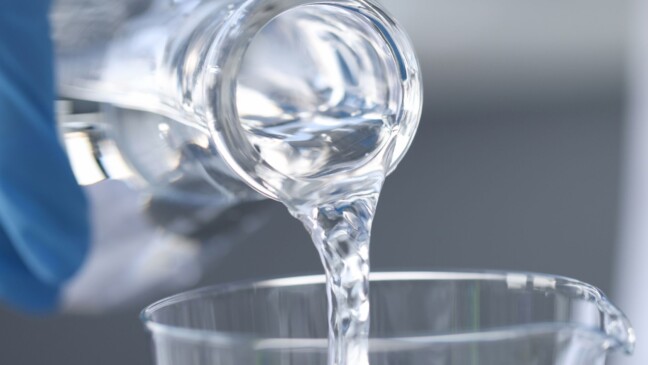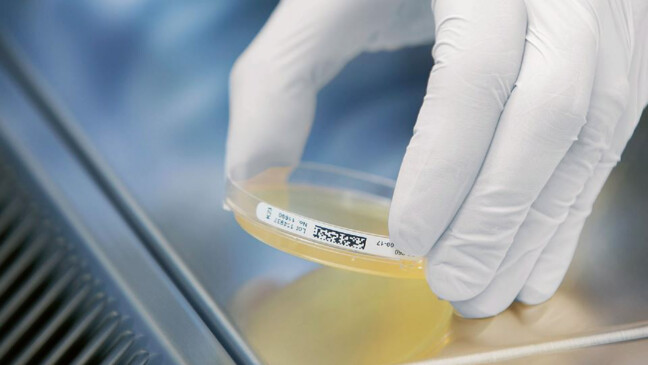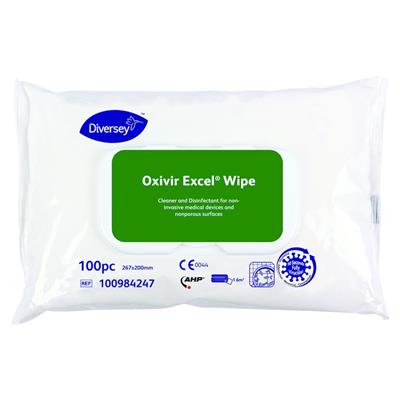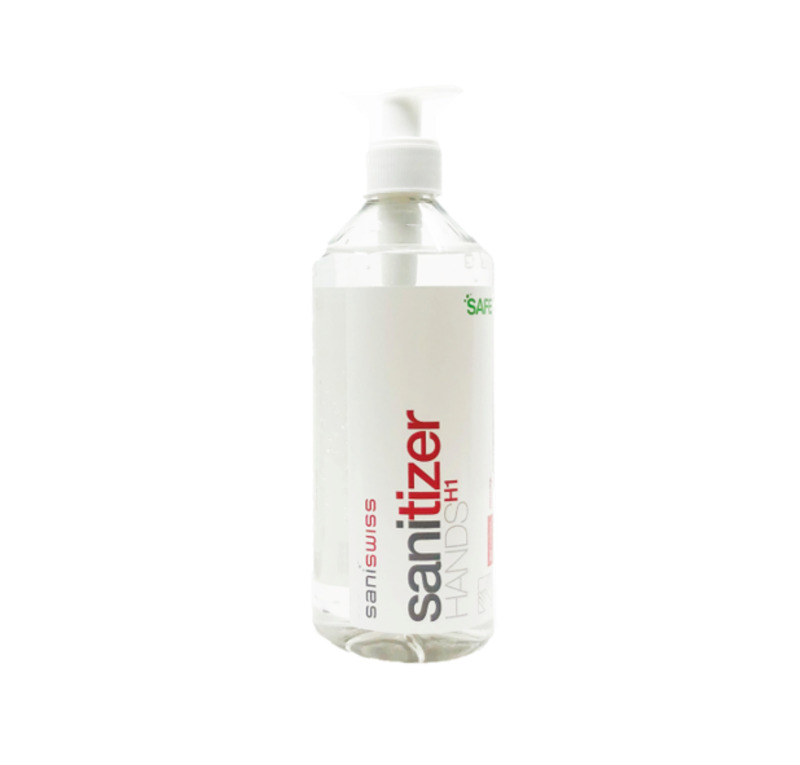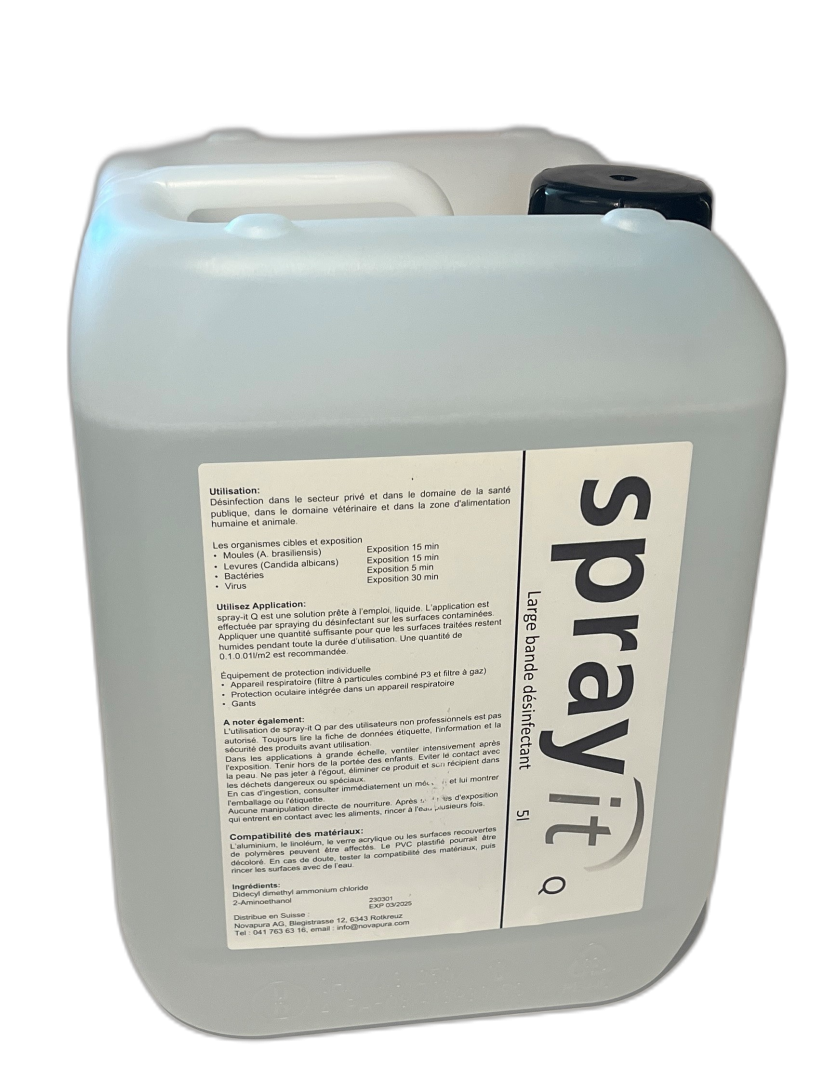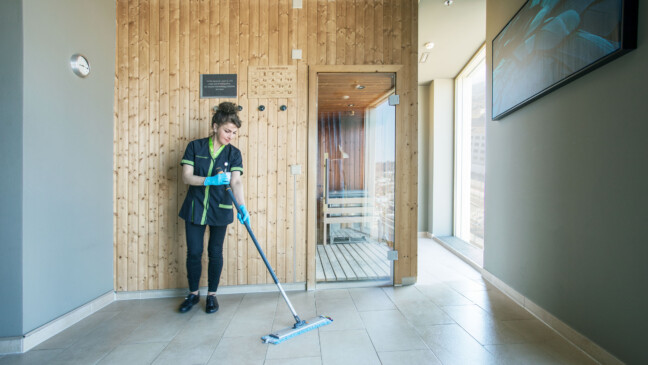
06.08.25
Efficient room decontamination with hydrogen peroxide (H₂O₂): Technology, processes and requirements
Microbiological safety in cleanrooms, pharmaceutical production facilities, hospitals and hygiene-critical areas is a key element of quality assurance. In these environments, where even the slightest contamination can have serious consequences, the choice of a reliable decontamination process is crucial. Automated room decontamination with hydrogen peroxide (H2O2) has established itself as a highly effective, reproducible and validatable method. It is increasingly supplementing or replacing manual disinfection, especially where the highest standards of hygiene, process safety and efficiency are required.
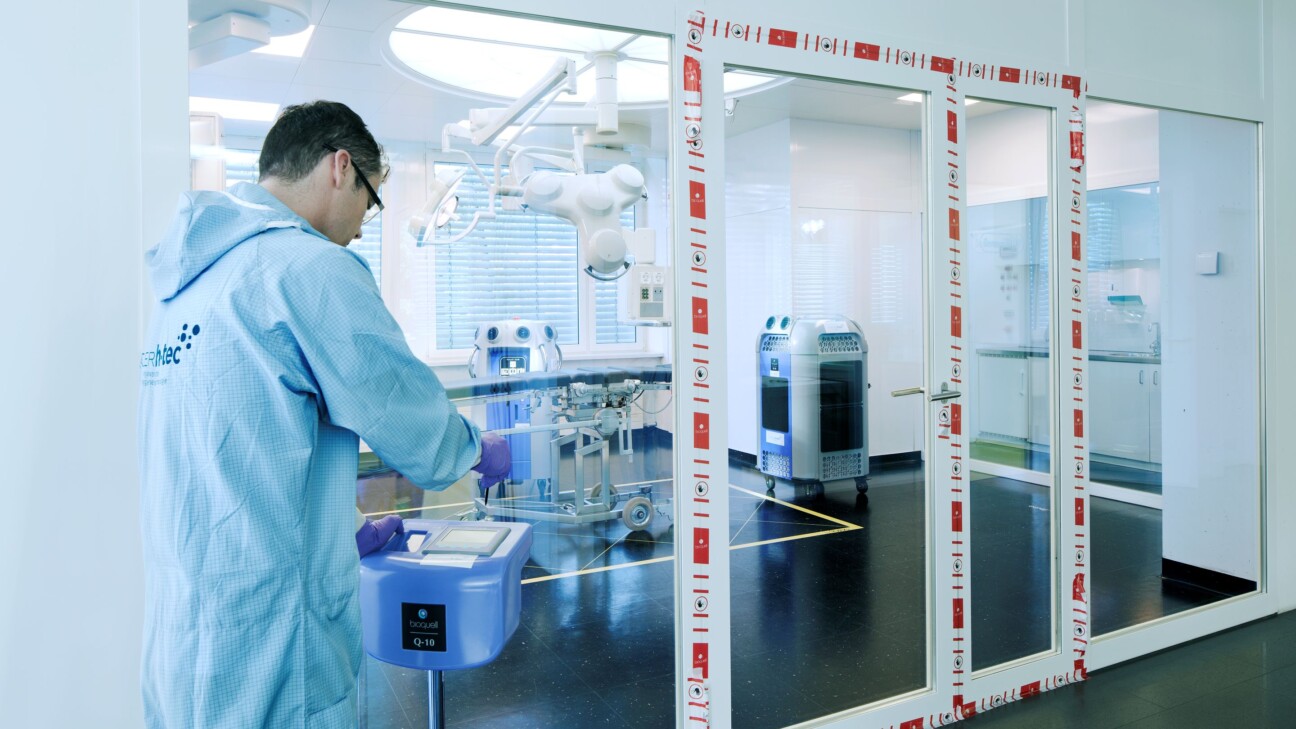
What is H2O2 decontamination?
H2O2 decontamination is an automated process for microbial inactivation in enclosed spaces. In this process, hydrogen peroxide is introduced into the room in the form of vapour or aerosol. The technology is based on the formation of microcondensation, which settles evenly on all surfaces and develops an oxidative effect there. This microcondensation is crucial for the high material compatibility and the even disinfection effect, even in areas that are difficult to access. After the reaction time, the H2O2 is decomposed into water and oxygen by catalysts, completing the process residue-free and odourless.
H2O2 biodecontamination is suitable for both preventive and corrective measures. It is used in cleanrooms, ventilation systems, safety cabinets and entire buildings – provided the environment can be sealed. The method is particularly effective against spores and achieves a reduction of up to 6 log levels.
Mode of operation and process flow
A complete cycle of H2O2 biodecontamination is divided into several phases. Firstly, the room is prepared, which includes zoning, closing off access points, installing airlocks and installing sensors and devices. In the first phase, the H2O2 generator is prepared. This is followed by nebulisation or fumigation, in which the hydrogen peroxide is introduced into the room. It is distributed via vapour generators and fans, which are interconnected to form a system depending on the size of the room.
During the exposure phase, microcondensation forms, which destroys microorganisms present on surfaces and in the air. The duration of this phase depends on the size of the room, the technology used and the desired microbiological reduction. The ventilation phase then begins, in which the H2O2 is broken down into harmless components by catalysers and fans. The process parameters such as temperature, humidity and H2O2 concentration are continuously monitored. Finally, final microbiological and chemical measurements are carried out to validate the success of the process.
Advantages of H2O2 Biodecontamination
Automated room decontamination with hydrogen peroxide offers numerous advantages over manual processes. The microbiological effectiveness is high and, depending on the process control, achieves a reduction of up to 6 log levels, which is particularly important for sporicidal applications. The method is reproducible and can be validated, which makes it GMP-compliant. As the process is residue-free and leaves no toxic residues, it is also suitable for sensitive production environments. Microcondensation ensures high material compatibility, which is particularly advantageous for sensitive devices and surfaces. In addition, areas that are difficult to access such as ventilation ducts, safety cabinets or complex room geometries can also be reliably decontaminated. Automation minimises production downtime, as the decontamination window is usually less than 24 to 48 hours.
Requirements and validation
The requirements for room decontamination depend heavily on the cleanroom class, the type of products manufactured and the microbiological risk analysis. The GMP guidelines require that cleaning and decontamination procedures have a known efficacy and are reproducible. In practice, this means that bioindicators with Geobacillus stearothermophilus are distributed in various concentrations (10⁴ to 10⁶ CFU) in the room, especially in places that are difficult to access. Complete validation with multiple cycle replication is not required in all cases. In GMP class D, a single cycle development with a 4 log reduction may be sufficient as long as manual disinfection has been carried out beforehand
Validation is carried out through microbiological sampling (e.g. swab samples, air samplings) and chemical monitoring of H2O2 concentrations. The use of bioindicators offers a realistic control, as they represent practical worst-case scenarios. However, validation requirements should be defined in a pragmatic and risk-based way to avoid unnecessary complexity and costs.
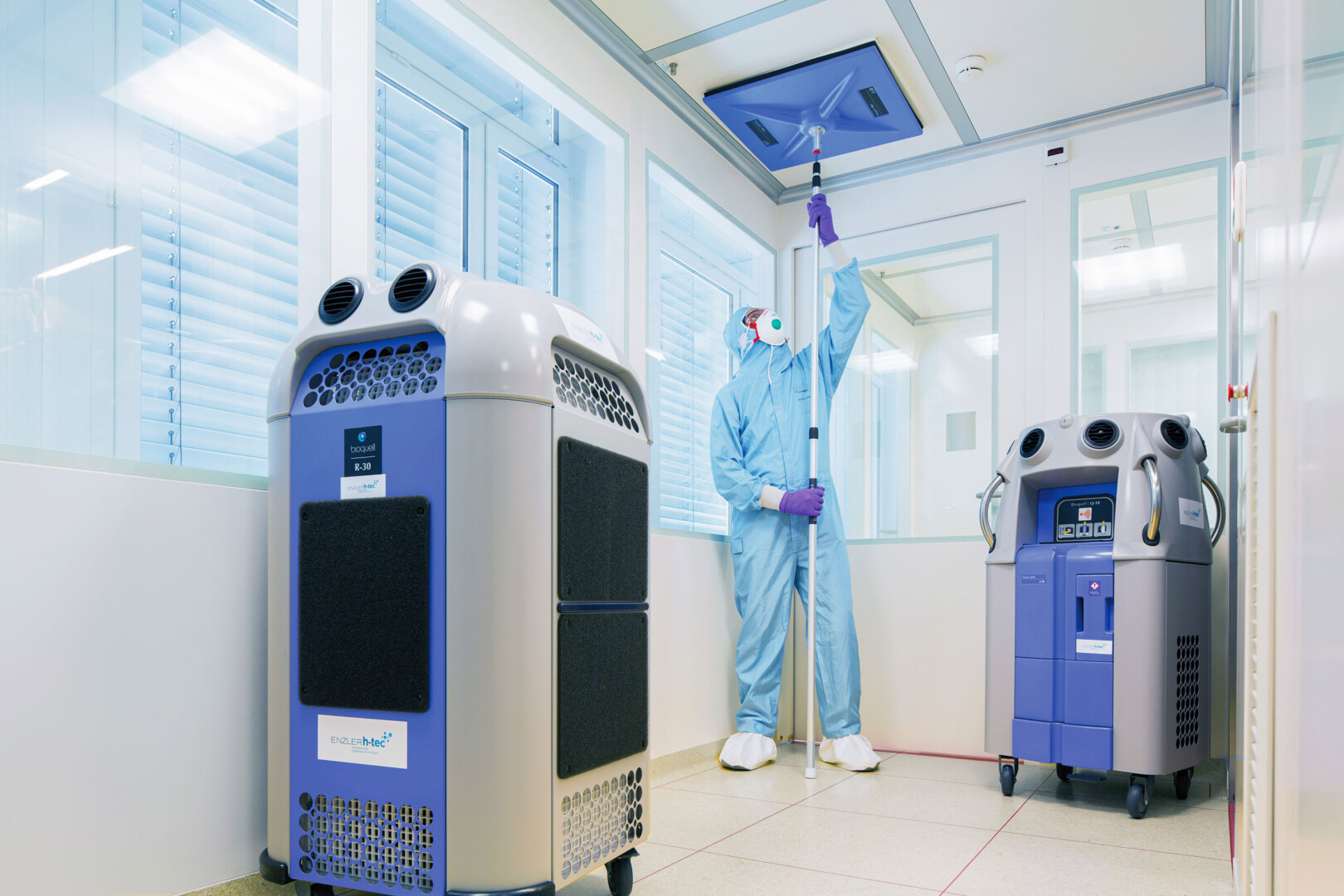
Protective measures and safety concepts
Carrying out H2O2 decontamination requires a comprehensive safety concept. This includes zone concepts with a clear separation between contaminated and decontaminated areas, airlock systems for access control and SOPs for all work steps. Staff must be trained, particularly with regard to behaviour, clothing and emergency measures. The equipment must have emergency shutdowns and the entire process must be continuously monitored. The safety precautions also include the compartmentalisation of ventilation systems, the installation of sensors and the documentation of all process steps. Only through such integral safety management can decontamination be carried out efficiently and without endangering people or the environment.
Summarised: Why H2O2 convinces
Room decontamination with hydrogen peroxide is an efficient, safe and economical method for microbiological control in sensitive areas. It is highly effective against a wide range of microorganisms, can be validated and can be flexibly adapted to different room sizes and requirements. A risk-based approach allows processes to be optimised, validation costs to be reduced and operating costs to be lowered. In many cases, the combination of manual disinfection and automated H2O2 biodecontamination is the ideal solution for ensuring the highest standards of hygiene – efficiently, sustainably and in line with regulatory requirements.
Practical implementation with experience and system
The implementation of H2O2 decontamination requires not only technical equipment, but also experience, precision and well thought-out project management. Enzler h-tec brings many years of expertise to the table – from conception to implementation and validation. As a general contractor, Enzler coordinates all steps and ensures smooth processes, even in complex environments. Supported by the company’s own Hygiene Competence Centre and a network of specialised partners, decontamination projects are individually planned and scientifically monitored. This results in a practical, safe and efficient process – tailored to the specific requirements on site.
Sources:
- Enzler Hygiene AG / Enzlerh-tec: Factsheet Raumdekontamination mit Wasserstoffperoxid (H2O2).
- Bruno Toraille: Biodekontamination mit H2O2 – Optimierung von bestehenden und neuen Zyklen, erschienen in ReinRaumTechnik 1/2017.
